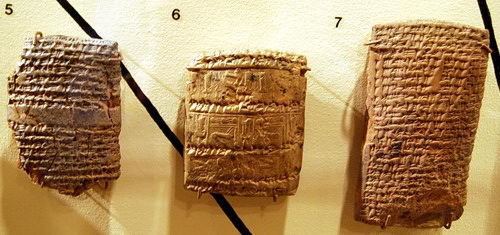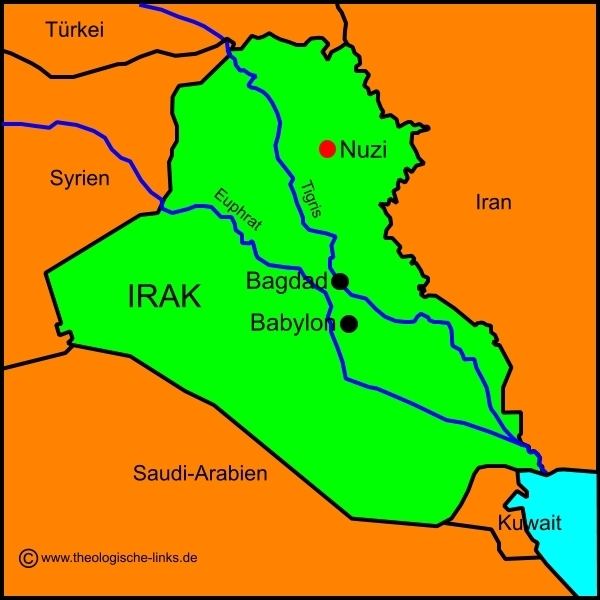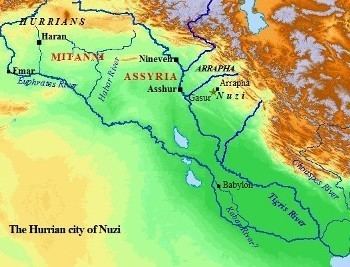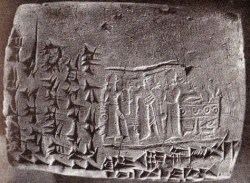Local time Tuesday 10:47 AM | ||
 | ||
Weather 14°C, Wind S at 11 km/h, 58% Humidity Similar Tell Brak, Marad, Sippar | ||
Nuzi (or Nuzu; Akkadian Gasur; modern Yorghan Tepe, Iraq) was an ancient Mesopotamian city southwest of Kirkuk in modern Al Ta'amim Governorate of Iraq, located near the Tigris river. The site consists of one medium-sized multiperiod tell and two small single period mounds.
Contents
- 06 20 15 ryan nuzi vs sam bass
- History
- Archaeology
- Nuzi a provincial town in the 14th century BC
- Administration
- References

06 20 15 ryan nuzi vs sam bass
History

The town of Gasur was apparently founded during the Akkadian Empire in the late third millennium BC. In the middle second millennium Hurrians absorbed the town and renamed it Nuzi. The history of the site during the intervening period is unclear, though the presence of a few cuneiform tables from Old Assyria indicates that trade with nearby Assur was taking place. After the fall of the Hurrian kingdom of Mitanni to the Hittites, Nuzi fell to the Assyrians and went into decline. Note that while Hurrian period is well known because those levels of the site were fully excavated, the earlier history is less firm because of only scanty digging. The history of Nuzi is closely interrelated with that of the nearby towns of Eshnunna and Khafajah.
Archaeology

While tablets from Yorghan Tepe began appearing back as far as 1896, the first serious archaeological efforts began in 1925 after Gertrude Bell noticed tablets appearing in the markets of Baghdad. The dig was mainly worked by Edward Chiera, Robert Pfeiffer, and Richard Starr under the auspices of the Iraq Museum and the Baghdad School of the American Schools of Oriental Research and later the Harvard University and Fogg Art Museum. Excavations continued through 1931. The site has 15 occupation levels. The hundreds of tablets and other finds recovered were published in a series of volumes. More finds continue to be published to this day.

To date, around 5000 tablets are known, mostly held at the Oriental Institute, the Harvard Semitic Museum and the Iraq Museum in Baghdad. Many are routine legal and business documents and about one quarter concern the business transactions of a single family. The vast majority of finds are from the Hurrian period during the second millennium BC with the remainder dating back to the town's founding during the Akkadian Empire. An archive contemporary to the Hurrian archive at Nuzi has been excavated from the "Green Palace" at the site of Tell al-Fakhar, 35 kilometres (22 mi) southwest of Nuzi.

Perhaps the most famous item found is the Nuzi map, which is the oldest known map ever discovered. It is unknown exactly what the Nuzi map charts, even though the majority of the tablet is preserved. The Nuzi map is actually one of the so-called Gasur texts, and predates the invasion of the city of Gasur by the Hurrians, who renamed it Nuzi. The cache of economic and business documents among which the map was found date to the Old Akkadian period (ca. 2360-2180 BC). Gasur was a thriving commercial center, and the texts reveal a varied business community with far reaching enterprises. It is possible that Ebla was a trading partner, and that the tablet, rather than a record of land-holdings, might indeed be a road map. The tablet, which is approximately 6 x 6.5 cm., is inscribed only on the obverse. It shows the city of Maskan-dur-ebla in the lower left corner, as well and a canal/river and two mountain ranges.
Nuzi, a provincial town in the 14th century BC

The best-known period in the history of Yorghan Tepe is by far one of the city of Nuzi in the 15th-14th centuries BC. The tablets of this period indicate that Nuzi was a small provincial town of northern Mesopotamia at this time in an area populated mostly by Hurrians, a people well known though poorly documented, and that would be even less if not for the information uncovered at this site.
Administration
Nuzi was a provincial town in the kingdom of Arrapha. It was administered by a governor (šaknu) from the palace. The palace, situated in the center of the mound, had many rooms arranged around a central courtyard. The functions of some of those rooms have been identified: reception areas, apartments, offices, kitchens, stores. The walls were painted, as was seen in fragments unearthed in the ruins of the building. Archives that have been exhumed tell us about the royal family, as well as the organization of the internal administration of the palace and its dependencies, and the payment in rations addicts received when working in his fields. Junior officers of the royal administration are sukkallu (often translated as "vizier", the second governor), the "district manager" (halṣuhlu), and the "mayor" (hazannu) were each responsible for an administrative level. Justice was rendered by these officers, but also by judges (dayānu) installed in the districts. Free subjects of the state were liable to a charge, the Ilku, which seems to consist of chores (military service, work for various government account, including its land). When a person sold land to another but remained to exploit it, they kept the burden of drudgery: the responsibility weighed on the operator and not the owner.
